Bloody Lane (Sunken Road)
9:30 a.m. to 1 p.m.
 Sumner's other two divisions from II Corp, under General William French and General Israel Richardson, angled to the left on their approach to the battle, marching through Roulette's Farm and Mumma's Farm.
Sumner's other two divisions from II Corp, under General William French and General Israel Richardson, angled to the left on their approach to the battle, marching through Roulette's Farm and Mumma's Farm.
Indeed, in one famous incident, a Confederate shell struck Roulette's beehives, taking a heavy toll on the 132nd Pennsylvanians--from the bees, not the shell.
At left, the view of Bloody Lane from the Tower (looking north), showing most of its 400-500 yard length. The Union attacked from the right of the photo.
French attacked first across the undulating terrain, charging against the positions to no avail. Charge after charge was repulsed until French withdrew his shattered forces.
At right, a Confederate view west from inside Bloody Lane. The Union crested the rise and attacked across the relatively flat ground.
At left, a view from the tower of the ground covered by Richardson's troops.
The 69th New York lost eight colour bearers, and Capt. Michael O'Sullivan of Company F, 63rd NY described the fight like this: "We have fought the enemy and our brigade has been cut to pieces. Every man in my company has either been killed or wounded, with the exception of eleven."
It was at this critical point that a Southern regiment was mistakenly pulled from the line, opening a gap that the Union quickly took advantage of. Now with enfilading fire, the Union quickly drove the outflanked defenders from Bloody Lane. A rapidly established defensive line was formed, but Richardson was mortally wounded and his command no longer able to press the attack.
One Brave Man
There is a story told by ex-Secretary of the Navy Herbert, who was fighting on the Confederate side, about a brave or foolhardy act of an unidentified soldier of the Irish Brigade. After the brigade pried the Confederates out of Bloody Lane back to the Piper Farmhouse, the Confederates counterattacked with some success. One Irish Brigade soldier lagged behind and paused to fire his gun at the advancing Confederates as fast as he could load it. Finally out of cartridges, he patted his now empty cartridge box and walked proudly away. Herbert said he felt for a moment like ordering his command to fire at this soldier, but on second thought found him too brave to be killed (From The Battlefield of Antietam).
Lee's center was about to cave in, and local Union commanders called on McClellan to release the corp in reserve, or at least part of it, to shatter what remained of the Confederate center. McClellan refused. The Confederate center, pushed back and hurting, nevertheless held.
Antietam
This article appears in MagWeb (Magazine Web) on the Internet World Wide Web. At left, Mumma's Farm, taken from the Mumma Cemetery and looking South. Roulette's Farm is beyond the trees. The Confederates burned the buildings to deny use to Union sharpshooters. At right, Roulette's Farm as seen from the Confederate viewpoint at the northernmost point of Bloody Lane. Note the bowed nature of the terrain as it drops to the right of the photo as well as slants downward into the distance. The light-colored roof of the farm is barely seen in the left part of the photo. A larger version (slow: 212K) of this panoramic view shows the sloping terrain.
At left, Mumma's Farm, taken from the Mumma Cemetery and looking South. Roulette's Farm is beyond the trees. The Confederates burned the buildings to deny use to Union sharpshooters. At right, Roulette's Farm as seen from the Confederate viewpoint at the northernmost point of Bloody Lane. Note the bowed nature of the terrain as it drops to the right of the photo as well as slants downward into the distance. The light-colored roof of the farm is barely seen in the left part of the photo. A larger version (slow: 212K) of this panoramic view shows the sloping terrain.
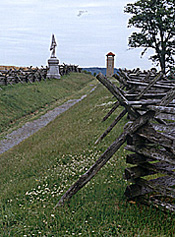 Still, the advance continued, but instead of supporting the attack by Sedgewick, they ran into Confederate General Danial Hill's Alabamian and North Carolinian troops entrenched in an eroded farm road that connected the hagerstown Pike with the Boonsboro Pike.
Still, the advance continued, but instead of supporting the attack by Sedgewick, they ran into Confederate General Danial Hill's Alabamian and North Carolinian troops entrenched in an eroded farm road that connected the hagerstown Pike with the Boonsboro Pike.
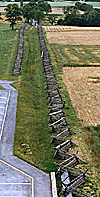 At right, Bloody Lane from roughly the mid point looking south to the Observational Tower. This 75-foot structure was built after the war on the southernmost point of the Lane, offering a 360-degree view of the battlefield. The Lane is approximately 4-5 feet deep at this point. The Union attacked from the left of the photo.
At right, Bloody Lane from roughly the mid point looking south to the Observational Tower. This 75-foot structure was built after the war on the southernmost point of the Lane, offering a 360-degree view of the battlefield. The Lane is approximately 4-5 feet deep at this point. The Union attacked from the left of the photo.
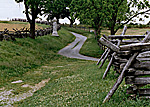 This sunken road, varying between three and six feet below the surrounding fields and bordered by split rail fences, would soon become known as Bloody Lane as 5,000 casualties resulted from a four-hour attack.
This sunken road, varying between three and six feet below the surrounding fields and bordered by split rail fences, would soon become known as Bloody Lane as 5,000 casualties resulted from a four-hour attack.
 At right, a view north from inside Bloody Lane. At left, another view north, with a 6-foot tall author inserted for perspective.
At right, a view north from inside Bloody Lane. At left, another view north, with a 6-foot tall author inserted for perspective.
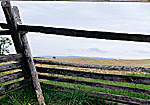 Richardson's troops, replacing French's, tried next, with much the same result.
Richardson's troops, replacing French's, tried next, with much the same result.
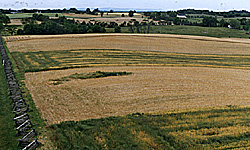 The Irish Brigade, for example, suffered 50-60% casualties trying to dislodge the North Carolinians from Bloody Lane.
The Irish Brigade, for example, suffered 50-60% casualties trying to dislodge the North Carolinians from Bloody Lane.
Introduction to Antietam Battlefield
The Campaign
Morning Phase: The Cornfield
Midday Phase: Bloody Lane (Sunken Road)
Afternoon Phase: Burnside's Bridge
Conclusion: Aftermath
Back to List of Battlefields
Back to Travel Master List
Back to MagWeb Master List of Magazines
© Copyright 1997 by Coalition Web, Inc.
Other military history articles and gaming articles are available at http://www.magweb.com